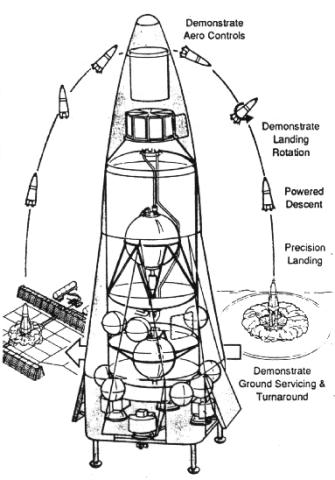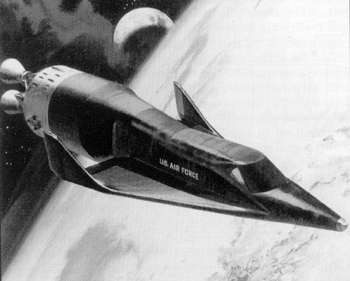Skip to comments.
NASA Receives Crew Exploration Vehicle Proposals
Space.com ^
Posted on 05/03/2005 2:22:46 PM PDT by JeffersonRepublic.com
KENNEDY SPACE CENTER, Florida -- The future of human space transportation, not only into Earth orbit, but also back to the Moon and onto Mars, kick-started this week as NASA received contractor proposals for the Crew Exploration Vehicle (CEV).
A glimpse into one concept -- provided by Lockheed Martin Space Systems near Denver, Colorado – shows a lifting body craft that can be outfitted for lunar as well as Mars operations.
“Basically what we came down on was the side of safety for the crew in making our decision to go with a lifting body,” said Patrick McKenzie, CEV Business Development Manager at Lockheed Martin Space Systems Company.
Additionally, the design of the basic vehicle would allow it to be utilized to support near-term human expeditions to the Moon, as well as Mars in the future, McKenzie told SPACE.com in a phone interview.
Lifting body approach
McKenzie said the lifting body design was preferred over a capsule for several reasons.
For one, that approach allows more cross-range maneuverability, thus the craft can touchdown on land versus water. Secondly, a lifting body can lessen the g-loads on returning crews from long-duration space stints, McKenzie said.
Whether they are lengthy stays in Earth orbit, a prolonged mission on the Moon, or the round-trip trauma on the human body from a Mars mission – the lifting body approach helps to minimize the g-forces on crew members, McKenzie noted.
Titanium shell
As part of a flight test program, McKenzie said that an unpiloted, full-scale version of the front-end of the company’s CEV design -- a rescue module -- would be flown to verify the safety elements of getting a crew back under a wide-range of circumstances. That would take place in 2008.
One feature of the company’s CEV design -- along with the firm’s teammates -- is use of a titanium shell, along with two layers of thermal protection materials.
“Even in the highly unlikely circumstance that you might have a burn through of the outer thermal protection system, the crew compartment inside would maintain its integrity and that burn through would not end up being a fatal situation for the crew,” McKenzie said.
Mars ready
McKenzie emphasized that the first mission for a CEV is returning to low Earth orbit. “But it makes sense to make sure that the vehicle that you’re developing this first go-round is going to be lunar capable,” he added, with the firm’s engineers also looking into how the concept could be made Mars ready.
“We’re attempting to the best extent possible to build in modularity into our systems and maintainability and ease of operations…so as new technologies and new capabilities are developed over the next 10 to 15 to 20 years, we’ll be able to take advantage of those without having to totally redesign a new vehicle,” McKenzie said.
McKenzie said that Lockheed Martin stands ready to work with NASA to help realize a stated objective of incoming NASA chief, Michael Griffin – to try and close the gap between shutdown of the shuttle in 2010 and operating a piloted CEV in 2014.
Furthermore, use of the CEV to support the International Space Station is on the table.
“Our CEV will certainly be capable of servicing station,” McKenzie stated, but the company’s proposal did not address that use as a key top requirement. This prospect would receive a thorough look early in the execution of a CEV program if the firm is selected, he said.
NASA has announced in the past the plan to award two teams CEV work this September.
TOPICS: Business/Economy; Government; News/Current Events
KEYWORDS: cev; lockheedmartin; mars; moon; space
Navigation: use the links below to view more comments.
first 1-20, 21-30 next last
McDonnell Douglas got screwed when NASA destoryed the Delta Clipper.

Lockheed Martin got screwed when NASA ask them to fund $300 million dollars of the X-33, only to annouce that Lockheed wouldn't get the contract for the venturestar.

I don't think it's very smart for these corporations to try to do business with NASA - it's bad for their shareholders.
To: JeffersonRepublic.com
My Personal choice:

2
posted on
05/03/2005 2:32:20 PM PDT
by
D Rider
To: JeffersonRepublic.com
Lockheed-Martin's proposal:


I don't quite see how this things lands on the Moon.
To: D Rider
My personal choice:

To: JeffersonRepublic.com


INSIDE THE CREW MODULE
1 Nitrous-oxide mono-propulsion system
2 Float bags
3 Micro-Meteoroid and Orbital Debris protection shield
4 Liquid oxygen long-term storage
5 Supersonic drogue chutes
6 Fuel cell
Read More HERE
http://www.freerepublic.com/focus/f-news/1395864/posts
5
posted on
05/03/2005 2:53:26 PM PDT
by
Robe
(Rome did not create a great empire by talking, they did it by killing all those who opposed them)
To: JeffersonRepublic.com
Given the cost of crossrange and lifting reentry, anyone proposing it should be shot in the public interest. It is the space launch equivalent of a sweaty guy in an overcoat on a summer day shouting, "Allahu akbar!"
To: Kenny Bunkport
My personal choice:

7
posted on
05/03/2005 3:02:50 PM PDT
by
Killborn
(Cardinal Joseph Ratzinger --> Pope Benedict XVI: God bless and keep him. May he reign in greatness.)
To: Kenny Bunkport
What a kluge! Lockmart really is losing it.
8
posted on
05/03/2005 3:11:36 PM PDT
by
Frank_Discussion
(May the wings of Liberty never lose a feather!)
To: hopespringseternal
I'll tell you right now, you've lost me.
9
posted on
05/03/2005 3:12:38 PM PDT
by
Frank_Discussion
(May the wings of Liberty never lose a feather!)
To: Frank_Discussion
What a kluge!You got that right. Looks like it's made of surplus space vehicle parts from the last 30 years.
To: Kenny Bunkport
Yeah... Who'd they hire to design their entry, Andy Griffith?
They had, what, a YEAR, to come up with something? And THIS is it? So, SO Sad.
11
posted on
05/03/2005 3:23:02 PM PDT
by
Frank_Discussion
(May the wings of Liberty never lose a feather!)
To: JeffersonRepublic.com
The USAF has screwed-over some aerospace companies as well --
The X-20 Dyna-Soar



To: Kenny Bunkport
THAT looks better that the current Lockheed proposal. repeat:
SO Sad...
13
posted on
05/03/2005 3:25:52 PM PDT
by
Frank_Discussion
(May the wings of Liberty never lose a feather!)
To: Frank_Discussion
And we're talking here of a concept (the X-20) that is over 40 years old. They trotted out this idea in 1962; had it gone through as originally envisioned, it would have pre-dated the Space Shuttle by 15 years.
To: Kenny Bunkport
Yeah, that's true, but the baseline X-20 wasn't a cargo carrier, IIRC. But imagine what could have been built from it. We'd need no CEV, we'd have it.
15
posted on
05/03/2005 3:30:18 PM PDT
by
Frank_Discussion
(May the wings of Liberty never lose a feather!)
To: Kenny Bunkport
Is Boeing going to put forth a CEV proposal?
16
posted on
05/03/2005 3:40:06 PM PDT
by
demlosers
(Rumsfeld: "We don't have an exit strategy, we have a victory strategy.'')
To: Kenny Bunkport
My choice.


17
posted on
05/03/2005 3:46:05 PM PDT
by
Paul_Denton
(Get the UN out of the US and US out of the UN!)
To: Paul_Denton
To: Frank_Discussion
Precisely. The history of the US space program is littered with oppotunities not taken, and we end up having to reinvent concepts that are 40 years old.
To: Kenny Bunkport
The opportunity was not taken because the PTB felt that the Shuttle concept would please the maximum number of users. Of course, that's somewhat true, but it does less than it was meant to, while X-20 died on the vine.
Reality sucks at times.
20
posted on
05/03/2005 3:59:13 PM PDT
by
Frank_Discussion
(May the wings of Liberty never lose a feather!)
Navigation: use the links below to view more comments.
first 1-20, 21-30 next last
Disclaimer:
Opinions posted on Free Republic are those of the individual
posters and do not necessarily represent the opinion of Free Republic or its
management. All materials posted herein are protected by copyright law and the
exemption for fair use of copyrighted works.
FreeRepublic.com is powered by software copyright 2000-2008 John Robinson













